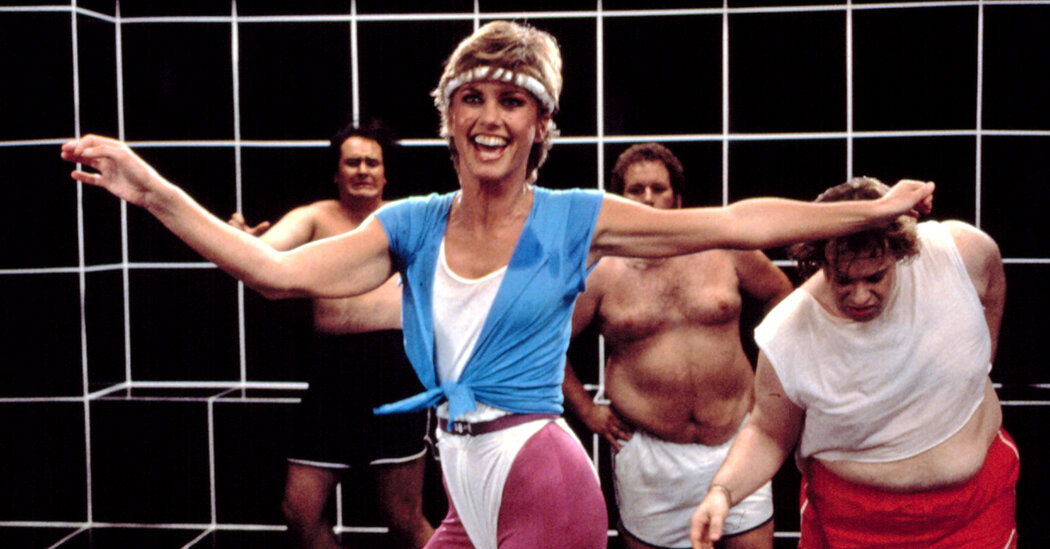The Lycra Legacy of Olivia Newton-John’s ‘Physical’

A funny thing happened when Kameron Lennox revisited the music video for “Physical,” the 1981 pop megahit by Olivia Newton-John, who died on Monday.
For most of the video, Ms. Newton-John bounces around a gym, training and terrorizing out-of-shape men while wearing a white leotard. In true 1980s fashion, that leotard was layered over magenta leggings and under a robin’s-egg blue shirt, cinched with a belt and accessorized with thick socks and a sweatband.
As a Hollywood costume designer preparing to work on the Apple TV+ aerobics dramedy also called “Physical,” starring Rose Byrne, Ms. Lennox saw something she hadn’t noticed when first watching the silly-sexy music video as a child.
The white leotard was “bunching in the groin area,” said Ms. Lennox, who wondered whether it was a leotard or one made from a large T-shirt. “The bottom kind of looks like a diaper. It looks very homemade. It looks like the fashions, actually, that were about to happen.”
Thanks to the video, which coincided with the dawn of MTV, “Physical” is remembered as a kind of anthem of the aerobics era — despite lyrics that are really more about copulation than cardio. Ms. Newton-John’s ensemble, too, has become a sartorial symbol of that era — despite the rudimentary construction of the leotard, which “definitely isn’t a workout outfit,” said Ms. Lennox, who ended up taking her costume design inspiration from lesser-known aerobics instructors like Bess Motta.
In that sense, the “Physical” ensemble is also an early example of athleisure, a term originally used to describe not exercise clothing but casual clothing that resembled exercise clothing.
As Ms. Newton-John explained in a video posted to her YouTube channel in December, the video “really helped kick off the entire fitness and aerobic craze of the time. It was the birth of the ’80s headband fashion craze. I should have started a headband and leg warmer company or made fitness videos. Jane Fonda beat me to it.”
It is true that no one popularized aerobics and the ballet-inspired aesthetic of aerobics more than Ms. Fonda, who opened a workout studio in 1979 and published the best-selling “Jane Fonda’s Workout Book” in 1981. But “Physical” came close, taking an aerosol hairspray can to a fitness trend — dance exercise — that was already poised to light up the decade. Not just because of the dance-centric pop culture phenomena of the decade (“Fame” in 1980, “Flashdance” in 1983,“Footloose” in 1984) but because of the re-emergence of a textile invented in 1958: Lycra, known generically as spandex.
Ms. Newton-John’s video “crystallized, in a short couple of minutes in visual form, what was happening across culture, manufacturing and consumer habits,” said Sonnet Stanfill, senior curator of fashion at the Victoria and Albert Museum and editor of the 2013 book “80s Fashion: From Club to Catwalk.”
In the 1970s, the textile industry began using Lycra — previously used as a substitute for rubber in women’s girdles — to create wardrobes around exercise. And so women attending classes or watching videos from Jazzercise or Jane Fonda were exposed to “a whole wardrobe they could buy to feel great when they were exercising,” Ms. Stanfill said, citing leotards and tights in a range of “almost-violent color tones.” Running bras had been invented and close to a decade had passed since Title IX increased the participation of women in sports — the options felt limitless.
“The last quarter of the 20th century in the U.S. was this kind of groundswell of celebrating the benefits of exercise and creating a wardrobe to go along with that,” she said. “Oftentimes changes in fashion are, particularly for women, connected to moments when sport has changed lifestyle.”
In high fashion, the designer Azzedine Alaïa was also using stretchy materials for his body-conscious designs — giving women a new opportunity to show off their toned bodies, Ms. Stanfill continued.
While the 1980s aerobic aesthetic mostly feels dated today, certain elements of that era have briefly come back into fashion. In the 2000s, before the spectacular fall of American Apparel’s founder, the company had reintroduced bright leotards and shiny leggings, with marketing that was more ironic and grungy-sexy than energetic and silly-sexy.
Yet the use of spandex never really went away, readapting as trendy yoga pants and leggings, then shapewear-as-outerwear. “The lasting legacy is that elasticated fiber that allows the body to move and can be quite flattering and form-fitting if you’re wanting to show off your figure,” Ms. Stanfill said.
But as Ms. Lennox discovered while trying to track down 1980s leotards for the show “Physical,” most of the Lycra of that era “did not stand the test of time.” Still, the playful spirit of Ms. Newton-John’s “Physical” continues to inspire clothing and culture (as seen in the Apple TV+ series or the 2020 Dua Lipa song, both of the same name).
When Outdoor Voices designed its first studio collection in 2019, it was influenced by the leotard-over-leggings look (punctuated by ballet wraps and skirts) pioneered by Ms. Newton-John and Ms. Fonda, said Ty Haney, the company’s founder and former chief executive.
But the inspiration went deeper: Outdoor Voices helped popularize athleisure in the 2010s by promoting movement outside of traditional exercise, favoring “doing things” (its tagline) over doing reps, blurring the lines between gym spandex and gardening spandex. Does a leotard have to be a performance leotard, or can it be one made for a wacky music video?
There was a “joyous perspective they brought to moving your body,” Ms. Haney said of Ms. Newton-John and Ms. Fonda. “Freeing fitness from performance!”
